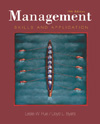 |  Management: Skills and Application, 10/e Leslie W Rue,
Georgia State University - Emeritus
Lloyd L Byars,
Georgia Institute of Technology
Organizing Work
Chapter Summary| 1. Define organization, and differentiate between a formal and an informal organization. An organization is a group of people working together in some type of concerted or coordinated effort to attain objectives. As such, an organization provides a vehicle for accomplishing objectives that could not be achieved by individuals working separately. The framework that defines the boundaries of the formal organization and within which the organization operates is the organization structure. The informal organization refers to the aggregate of the personal contacts and interactions and the associated groupings of people working within the formal organization. The informal organization has a structure, but it is not formally and consciously designed.
2. Explain the importance of the organizing function. The organizing function determines how organizational resources will be employed to achieve goals. It also establishes lines of authority, improves the efficiency and quality of work through synergism, and improves communication by defining channels of communication in the organization.
3. List the advantages and the major disadvantage of horizontal division of labor. Horizontal division of labor can result in the following advantages: (1) fewer skills are required per person; (2) it is easier to supply the skills required for selection or training purposes; (3) practice in the same job develops proficiency; (4) primarily utilizing each worker's best skills promotes efficient use of skills; (5) concurrent operations are made possible; and (6) there is more conformity in the final product if each piece is always produced by the same person. The major disadvantage of horizontal division of labor is that it can result in job boredom and even degradation of the worker.
4. Distinguish among power, authority, and responsibility. Power is the ability to influence, command, or apply force. Power is derived from the control of resources. Authority is power derived from the rights that come with a position; it is the legitimate exercise of power. Responsibility is accountability for the attainment of objectives, the use of resources, and the adherence to organizational policy. Once responsibility is accepted, performing assigned work becomes an obligation.
5. Explain the concept of centralization versus decentralization. Centralization and decentralization refer to the degree of authority delegated by upper management. This is usually reflected by the numbers and kinds of decisions made by the lower levels of management. As they increase, the degree of decentralization also increases. Thus, an organization is never totally centralized or totally decentralized: rather, it falls along a continuum ranging from highly centralized to highly decentralized.
6. Define empowerment. Empowerment is a form of decentralization that involves giving subordinates substantial authority to make decisions.
7. List four principles of organization that are related to authority. Four principles of organization related to authority are (1) the parity principle, (2) the unity of command principle, (3) the scalar principle, and (4) span of management.
8. Identify several reasons managers are reluctant to delegate. A manager's resistance to delegating authority is natural. Several reasons managers are reluctant to delegate include the following: (1) fear of subordinates failing; (2) it is easier for the manager to do the task than to teach a subordinate how to do it; (3) fear that subordinates will look "too good"; (4) humans' attraction to power; and (5) comfort in doing those tasks that should be delegated.
9. Recount the major factors that affect a manager's span of management. The major factors that affect a manager's span of management are (1) the complexity of the job being managed, (2) the variety among the jobs being managed, (3) the physical proximity of the jobs to one another, (4) the general quality of the subordinates being managed, and (5) the ability of the manager to perform the different managerial duties.
10. Name and define three workplace changes, in addition to decentralization and empowerment, that have affected the organizing function in today's organizations. The use of flextime, telecommuting, and job sharing have affected today's organizations. Flextime allows employees to choose, within certain limits, when they start and end their workday. Telecommuting is the process of working away from a traditional office--usually at home. Job sharing is where two more part-time individuals perform a job that would normally be held by one full-time person. |
|



 2003 McGraw-Hill Higher Education
2003 McGraw-Hill Higher Education